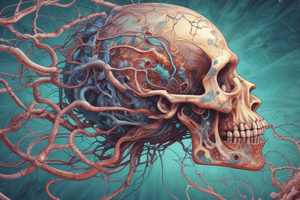Podcast
Questions and Answers
What is the name of the abnormal brain development commonly associated with spina bifida?
What is the name of the abnormal brain development commonly associated with spina bifida?
- Chiari I malformation
- Holoprosencephaly
- Chiari II malformation (correct)
- Encephalocele
Which of the following is NOT a common congenital defect associated with spina bifida?
Which of the following is NOT a common congenital defect associated with spina bifida?
- Abnormal genitourinary tract development
- Heart malformations
- Intellectual disability (correct)
- Cleft lip or palate
Which of the following is a common symptom of myelomeningocele, a severe form of spina bifida?
Which of the following is a common symptom of myelomeningocele, a severe form of spina bifida?
- Muscle weakness or paralysis below the level of the incompletely closed spine (correct)
- Increased reflexes and spasticity
- Seizures
- Increased intracranial pressure
What is the purpose of shunting procedures in the treatment of spina bifida?
What is the purpose of shunting procedures in the treatment of spina bifida?
Which of the following is NOT a type of assistive device commonly used by individuals with spina bifida?
Which of the following is NOT a type of assistive device commonly used by individuals with spina bifida?
How are new insights into the genetics and epigenetics of spina bifida expected to impact the condition?
How are new insights into the genetics and epigenetics of spina bifida expected to impact the condition?
What is the most severe form of spina bifida?
What is the most severe form of spina bifida?
What is the primary cause of spina bifida?
What is the primary cause of spina bifida?
Which of the following is NOT a common physical symptom associated with spina bifida?
Which of the following is NOT a common physical symptom associated with spina bifida?
What is the condition where cerebrospinal fluid builds up in the brain, which can potentially lead to serious complications?
What is the condition where cerebrospinal fluid builds up in the brain, which can potentially lead to serious complications?
Which of the following is considered a less severe form of spina bifida?
Which of the following is considered a less severe form of spina bifida?
What is the name of the group of disorders that spina bifida belongs to?
What is the name of the group of disorders that spina bifida belongs to?
Flashcards are hidden until you start studying
Study Notes
Spina Bifida: Understanding the Complexities of a Developmental Disorder
Introduction
Spina bifida is a congenital abnormality affecting the nervous system, specifically involving the formation of the spinal cord. It is a member of a group of disorders known as neural tube defects, which also includes encephalocele and anencephaly. Spina bifida occurs when the fetus's developing spinal column fails to close properly within the first 28 days after conception.
This complex condition can manifest in different forms, the most severe being myelomeningocele, where a portion of the spinal cord itself protrudes through an opening in the back. Less severe forms include spina bifida occulta, where the spinal column is only partially closed, and meningocele, where part of the protective membrane covering the spinal cord protrudes.
Cleft Spine and Developmental Defects
Children with spina bifida may experience various physical symptoms depending on the severity of their condition. These can include muscle weakness, paralysis below the level of the incompletely closed spine, loss of sensation, and difficulties with bladder or bowel control due to damaged nerves. Additionally, some children may suffer from hydrocephalus, a condition where cerebrospinal fluid builds up in the brain, which can potentially lead to serious complications such as blindness or seizures if left untreated.
Moreover, spina bifida often co-occurs with other developmental defects. Abnormal brain development, known as Chiari II malformation, is commonly associated with spina bifida. Children may also be born with a cleft lip or palate, heart malformations, and abnormal genitourinary tract development.
Symptoms and Treatment
The symptoms of spina bifida vary in severity. For example, children with myelomeningocele may have muscle weakness or paralysis below the level of the incompletely closed spine, loss of sensation, and difficulties with bladder or bowel control due to damaged nerves. Additionally, they can experience hydrocephalus, which requires intervention such as shunting procedures to drain excess fluid from the brain into the abdomen and control hydrocephalus.
Children with spina bifida require various treatments and interventions throughout their lives. They typically learn how to use assistive devices like wheelchairs, crutches, or braces to improve mobility. Educational support may be necessary to address potential learning difficulties associated with the condition. Treatment for complications, such as constipation or urinary infections, may involve medication, surgery, or physical therapy.
Impact and Future Directions
Spina bifida affects individuals, their families, medical science, and society in numerous ways. New insights into the genetics and epigenetics underlying the condition are expected to enhance our understanding of spina bifida causation, potentially enabling better prevention strategies. Additionally, ongoing efforts aim to improve existing treatments and develop novel interventions to promote independence and social skills among affected individuals.
Studying That Suits You
Use AI to generate personalized quizzes and flashcards to suit your learning preferences.




